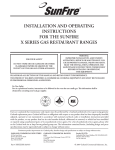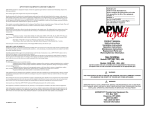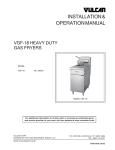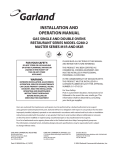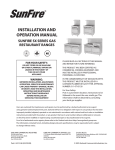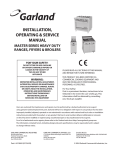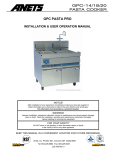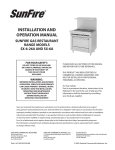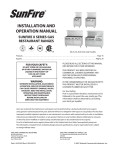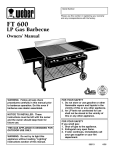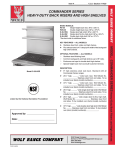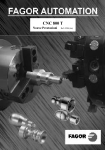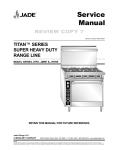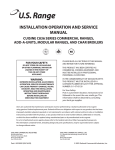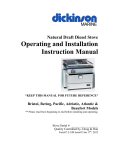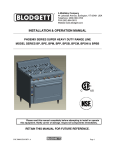Download User Manual - Comkit Online
Transcript
INSTALLATION AND OPERATION MANUAL MASTER SERIES HEAVY DUTY GAS RANGES AND CHAR BROILERS, ALL M/MS/MST SERIES MODELS FOR YOUR SAFETY: DO NOT STORE OR USE GASOLINE OR OTHER FLAMMABLE VAPORS OR LIQUIDS IN THE VICINITY OF THIS OR ANY OTHER APPLIANCE WARNING: IMPROPER INSTALLATION, ADJUSTMENT, ALTERATION, SERVICE OR MAINTENANCE CAN CAUSE PROPERTY DAMAGE, INJURY, OR DEATH. READ THE INSTALLATION, OPERATING AND MAINTENANCE INSTRUCTIONS THOROUGHLY BEFORE INSTALLING OR SERVICING THIS EQUIPMENT PLEASE READ ALL SECTIONS OF THIS MANUAL AND RETAIN FOR FUTURE REFERENCE. THIS PRODUCT HAS BEEN CERTIFIED AS COMMERCIAL COOKING EQUIPMENT AND MUST BE INSTALLED BY PROFESSIONAL PERSONNEL AS SPECIFIED. IN THE COMMONWEALTH OF MASSACHUSETTS THIS PRODUCT MUST BE INSTALLED BY A LICENSED PLUMBER OR GAS FITTER. For Your Safety: Post in a prominent location, instructions to be followed in the event the user smells gas. This information shall be obtained by consulting your local gas supplier. Users are cautioned that maintenance and repairs must be performed by a Garland authorized service agent using genuine Garland replacement parts. Garland will have no obligation with respect to any product that has been improperly installed, adjusted, operated or not maintained in accordance with national and local codes or installation instructions provided with the product, or any product that has its serial number defaced, obliterated or removed, or which has been modified or repaired using unauthorized parts or by unauthorized service agents. For a list of authorized service agents, please refer to the Garland web site at http://www.garland-group.com. The information contained herein, (including design and parts specifications), may be superseded and is subject to change without notice. GARLAND COMMERCIAL RANGES, LTD. 1177 Kamato Road, Mississauga, Ontario L4W 1X4 CANADA Phone: 905-624-0260 Fax: 905-624-5669 Part##1382680 1382680Rev Rev22(12/09/10) (12/09/10) Part © 2005 Garland Commercial Industries, Inc.1 Page IMPORTANT INFORMATION WARNING: This product contains chemicals known to the state of California to cause cancer and/or birth defects or other reproductive harm. Installation and servicing of this product could expose you to airborne particles of glass wool/ceramic fibers. Inhalation of airborne particles of glass wool/ceramic fibers is known to the state of California to cause cancer. Operation of this product could expose you to carbon monoxide if not adjusted properly. Inhalation of carbon monoxide is known to the state of California to cause birth defects or other reproductive harm. Keep appliance area free and clear of combustibles. Page 2 Part # 1382680 Rev 2 (12/09/10) TABLE OF CONTENTS IMPORTANT INFORMATION. . . . . . . . . . . . . 2 SPECIFICATIONS . . . . . . . . . . . . . . . . . . . . . . . 4 Clearance from Combustible Construction . . . . 4 Clearance from Non-Combustible Construction. . . . . . . . . . . . . . . . . . . . . . . . . . . . . . . . . 4 INSTALLATION . . . . . . . . . . . . . . . . . . . . . . . . . 5 Rating Plate. . . . . . . . . . . . . . . . . . . . . . . . . . . . . . . . . . 5 Valve Controlled Griddles (M Models) . . . . . . . . 13 Valve controlled Griddles (MS/MST Models) . . 13 Oven (Standard) . . . . . . . . . . . . . . . . . . . . . . . . . . . . 13 “RC” Convection Ovens. . . . . . . . . . . . . . . . . . . . . . 13 Char-Broiler (M.MS Models) . . . . . . . . . . . . . . . . . . 14 Char-Broiler (MST Models):. . . . . . . . . . . . . . . . . . . 14 Assembly of Char-Broiler: . . . . . . . . . . . . . . . . . . . . 15 Gas Installation . . . . . . . . . . . . . . . . . . . . . . . . . . . . . . 5 MAINTENANCE . . . . . . . . . . . . . . . . . . . . . . . 15 Installation of ovens equipped with casters . . . 5 Painted Finishes . . . . . . . . . . . . . . . . . . . . . . . . . . . . 15 Legs . . . . . . . . . . . . . . . . . . . . . . . . . . . . . . . . . . . . . . . . . 6 Stainless Steel Finishes . . . . . . . . . . . . . . . . . . . . . . 15 Ventilation and Air Supply . . . . . . . . . . . . . . . . . . . . 6 Oven Interior (Porcelain Enamel) . . . . . . . . . . . . . 16 Installation of Oven Flue Riser . . . . . . . . . . . . . . . . 6 Oven Interior – Optional continuous Clean . . . 16 Installation Instructions for Low Profile Backguard . . . . . . . . . . . . . . . . . . . . . . . 6 Automatic Pilot Valve . . . . . . . . . . . . . . . . . . . . . . . 16 Installation Instructions for High Profile Backguards and Shelves . . . . . . . . . . 7 Griddle Cleaning . . . . . . . . . . . . . . . . . . . . . . . . . . . . 17 Installation Instructions for Salamander or Cheesmelter . . . . . . . . . . . . . . . . . . 7 Assembly of Battery . . . . . . . . . . . . . . . . . . . . . . . . . . 7 Griddle Seasoning . . . . . . . . . . . . . . . . . . . . . . . . . . 16 Open Top Burners . . . . . . . . . . . . . . . . . . . . . . . . . . 17 Top Grates Seasoning Cast Iron Top Grates . . . . . . . . . . . . . . 17 Cast Iron Hot tops and Spectro-Heat Tops . . . . 18 Optional Common Rail Installation . . . . . . . . . . . . 8 Pressure Regulators . . . . . . . . . . . . . . . . . . . . . . . . . 11 ADJUSTMENTS. . . . . . . . . . . . . . . . . . . . . . . . 18 Testing and Adjustments . . . . . . . . . . . . . . . . . . . . 11 Pilot Adjustment . . . . . . . . . . . . . . . . . . . . . . . . . . . 18 OPERATION. . . . . . . . . . . . . . . . . . . . . . . . . . . 12 Open top burners (M/MS Models) . . . . . . . . . . . 12 Burner Gas/Air Adjustments . . . . . . . . . . . . . . . . . 18 FDO Heavy Duty Oven control . . . . . . . . . . . . . . . 19 BJWA Griddle Thermostat . . . . . . . . . . . . . . . . . . .20 Open top burners (MST Models) . . . . . . . . . . . . . 12 Hot top Sections and Spectro-Top Sections (M Models) . . . . . . . . . . . . . . . . . . . . . . . . . . . . . . . . . 12 CONVECTION OVEN USER TIPS – SUFFIX “RC” . . . . . . . . . . . . . . . . . . . . . . . . . . 21 Hot Top Sections and Spectro-Top Sections (MS/MST Models) . . . . . . . . . . . . . . . . . . . . . . . . . . . 12 TROUBLE SHOOTING CONVECTION OVEN . . . . . . . . . . . . . . . . . . . 21 Thermostatically Controlled Griddles (M Models) . . . . . . . . . . . . . . . . . . . . . . . . . . . . . . . . . 12 Part # 1382680 Rev 2 (12/09/10) Page 3 SPECIFICATIONS MODEL NUMBER GAS TYPE NATURAL GAS TYPE-PROPANE INPUT (BTU/H) INPUT (BTU/H) (M,MS)(12,43) Open Burner 24,000 20,000 MST43 Open Burner 24,000 20,000 M43-(1,2,3) Hot top burner 22,000 22,000 M43 FTR Front Open Burner 18,000 16,000 Rear French top 15,000 16,000 (M, MS)(4,42,44,54) Open Burner 35,000 35,000 MST(42,44,54) Open burner 35,000 35,000 (M,MS)(45,54,5) Spectro Heat Burner 15,000 11,000 Total of 3 burners 40,000 Total of 3 burners 40,000 M(42-6,46,6,12S-6) Even Heat Hot Top Burner. 30,000 30,000 MST(42-6,46,6) Even Heat Hot Top Burner 27,000 27,000 (M,MS)47 Griddle burner 33,000 33,000 MST 47 Griddle Burner 30,000 30,000 M48 Griddle Burner 33,000 33,000 (M,MS,MST) Oven Burner 40,000 35,000 (M,MS,MST)(17,24,34) Char-Broiler 15,000 15,000 MST45 Spctro Heat Burner (M1R) Single deck oven section 40,000 40,000 (M2R) Double stacked ovens 80,000 80,000 Natural Gas Operating Pressure=6.0” Water Column, measured at manifold tap. Propane Gas Operating Pressure=10.0” Water Column, measured at manifold tap. Clearance from Combustible Construction Models (M,MST)5(S,T) & (M,MST)45(R,RC,S,T) must be installed with no less than six inch (6”) clearance from combustible construction at sides and rear. Models (M,MS,MST)42(R,RC,S,T), (M,MS,MST) 44(R,RC,S,T), (M,MS,MST)54(R,RC,S,T), (M,MS, MST)4(S,T), (M,MST)46(R,RC,S,T), (M,MST)47 (R,RC,S,T), M47-23(R,RCS,T), M47-45(R,RC,S,T), M48(R,RCS,T), M48-23(R,RC,S,T), M48-45(R,RC,S,T) (M,MST)(6,7,8)(S,T) must be installed with no less than fourteen inches (14”) on the side, and six inch (6”) rear clearance from combustible construction. Clearance from Non-Combustible Construction Models (M,MS,MST)(17,24,34)B(E) are for INSTALLATION IN NON-COMBUSTIBLE LOCATIONS ONLY with zero (0”) sides and rear clearance. Models with suffix “RC” must be installed with zero inches (0”) side and no less than one inch (1”) rear clearance from non-combustible construction. All other models may be installed with zero inches (0”) sides and rear clearance from non-combustible construction. Models (M,MS,MST)43(R,RC,S,T) must be installed with no less than eleven inch (11”) side and six inch (6”) rear clearance from combustible construction. Page 4 Part # 1382680 Rev 2 (12/09/10) INSTALLATION Rating Plate When corresponding with the factory or your local authorized factory service center regarding service problems or replacement parts, be sure to refer to the particular unit by the correct model number (including the prefix and suffix letters and numbers) and the warranty serial number. The rating plate affixed to the unit contains this information. We suggest installation, maintenance and repairs should be performed by your local authorized service agency listed in your information manual pamphlet. NOTE: When checking gas pressure be sure that all other equipment on the same gas line is on. A pressure regulator is not supplied as standard equipment with GARLAND Heavy Duty equipment, however a 1-1.4” pressure regulator is sold as an option with the original purchase. If you would like to purchase a regulator after original purchase contact your equipment dealer. Installation must conform with the National fuel Gas code ANSI Z223-1-1988 or latest edition, NFPA No. 54 – Latest Edition and National electrical code ANSI/NFPA 70-1990 or latest edition and/or local code to assure safe and efficient operation. In the event you have any questions concerning the installation, use, care or service of the product, write or call our Product Service Department. In Canada, the installation must comply with CAN/CGA-B149.1 NATURAL GAS INSTALLATION CODE, or CAN/CGA-B149.2 PROPANE GAS INSTALLATION CODE, and local codes where applicable. This product must be installed by professional personnel as specified. Garland/U.S. Range products are not approved or authorized for home or residential use, but are intended for commercial applications only. Garland / U.S. Range will not provide service, warranty, maintenance or support of any kind other than in commercial applications. In Canada, electrical connection must comply with applicable sections of the Canadian Electrical Codes, C22.1 – 1990 (or latest edition), “Safety Standard for Installation, Part 1” and C22.2 – No O-M 1982 (or latest edition), “General Requirements, Part 2”. Gas Installation Before assembly and connection check gas supply. A. The type of gas for which the unit is equipped is stamped on the data plate located behind the lower front panel. Connect a unit stamped on the data plate located behind the lower front panel. Connect a unit stamped “NAT” only to natural gas; connect those stamped “PRO” only to propane gas. B. If it is a new installation have the gas authorities check meter size and piping to assure that the unit is supplied with sufficient amount of gas pressure required to operate the UNIT. C. If it is additional or replacement equipment have gas authorities check pressure to make certain that existing meter and piping will supply fuel to the unit with not more than 1/2” water column pressure drop. NOTE: The appliance must be isolated from the gas supply piping system by closing its individual manual shut-off (not supplied by manufacturer) during any testing of the gas supply piping system at test pressures equal to or less than 1/2 PSIG (3.45 KPA). NOTE: Adequate clearance must be provided for servicing and proper operation. NOTE: This appliance is not recommended for residential installation. Installation Of Ovens Equipped With Casters A. The installation shall be made with a connector that complies with the Standard for Connectors for Moveable Gas Appliances, ANSI Z21.69/CSA 6.16, Addenda Z21.69B2006/CSA 6.16B-2006 (or latest edition), and a quickdisconnect device that complies with the Standard for Quick Disconnects for Use with Gas Fuel, ANSI Z21.41/ CSA 6.9, Addenda Z21.41A-2005/CSA 6.16A-2005 (or latest edition). B. The front casters of the unit are equipped with brakes to limit the movement of the range without depending on the connector and any quick-disconnect device or its associated piping to limit the appliance movement. Part # 1382680 Rev 2 (12/09/10) Page 5 INSTALLATION Continued C. Please be aware, required restraint is attached to a bracket (which is located on the left rear caster), and if disconnection of the restraint is necessary, be sure to reconnect the restraint after the oven has been returned to its originally installed position. Installation Instructions for Low Profile Backguard Legs 2. Remove front panel, (5), by lifting upward. Raise front of the unit and block do not lay unit on its back. Position leg insert into leg retainer opening and tap up until it seats at collar flange. Repeat at rear of unit making sure all four legs are adjusted to same height. Legs can be adjusted to overcome an uneven floor. 3. With back panel, (4), still attached to the uprights, (2 & 3), drop the uprights into the rectangular openings at the rear of the range. (1). Ventilation and Air Supply Proper ventilation is highly important for good operation. The ideal method of ventilating a range is the use of a properly designed canopy which should extend approximately six inches (6”) beyond all sides of the appliance and six feet (6’) six inches (6”) from the floor. 1. Remove flue cap, (6), by removing six, (6), #10 sheet metal screws. 4. Fasten the uprights, (2 & 3), to the range with four (4), 5/16” x 18 and flat washers, (7 & 8). 5. If the range is in a battery line-up, fasten units together at hole marked “X” with ¼” x 20 bolts, nuts and washers. 6. Reattach the front panel, (5) to the backguard with sheet metal screws previously removed. 7. Reinstall flue cap, (6), to top of backguard. A strong exhaust fan will create a vacuum in the room, for an exhaust system vent to work properly, replacement air must enter the room in which the vent is located. All gas burners and pilots need sufficient air to operate and large objects should not be placed in front of this oven which would obstruct the air flow through the front. 6 3 9 7 4 8 Installation of Oven Flue Riser The oven flue is packed inside the oven for shipping purposes. Before installing the back guard, high shelf or range mount salamander you must install the oven flue riser. Remove the two #10 sheet metal screws from the rear center of the main top. Position the oven flue riser over the center square hold with the flat surface to the rear of the range. Reinstall the two #10 sheet metal screws, securing the oven flue riser to the rear main top. ~ 2 5 "X" "X" ~ 1 Page 6 Part # 1382680 Rev 2 (12/09/10) INSTALLATION Continued Installation Instructions for High Profile Backguards and Shelves 3. Fasten the uprights, (2 & 3), to the range with four, (4), 5/16” x 18 and flat washers, (6 & 7). 1. Remove front panel, (5), by lifting upward. 4. If the range is in a battery line-up, fasten units together at hole marked “X” with 1/4” x 20 bolts, nuts and washers. 2. With back panel, (4), still attached to the uprights, (2 &3), drop the uprights into the rectangular openings at the rear of the range, (1). 5. Reattach the front panel, (5) to the salamander or cheesemelter with sheet metal screws previously removed. 3. Fasten the uprights, (2 & 3), to the range with four, (4), 5/16” x 18 and flat washers, (6 & 7). 4. If the range is in a battery line-up, fasten units together at hole marked “X” with 1/4” x 20 bolts, nuts and washers. 4 5. Reattach the front panel, (5) to the backguard with sheet metal screws previously removed. d an rl Ga 3 8 3 4 6 6 7 7 2 8 5 "X" "X" 2 5 ~ 1 "X" "X" 1 Assembly of Battery All heavy duty batteried equipment is aligned and fitted at the factory, from left to right and must be installed in this order. There is a diagram provided with every heavy duty battery. Installation Instructions for Salamander or Cheesmelter All models described, except model M110XMmay be installed to battery with GARLAND M/MS/MST40 Series Ranges, sharing common manifold connections. 1. Remove front panel, (5), by removing two, (2), sheet metal screws from the underside of the salamander or cheesemelter. A. All such units should be placed in their respective battery position. Detach valve panels to prevent damage, remove them from the area where the battery is being assembled. 2. With back panel, (4), still attached to the uprights, (2 & 3), drop the uprights into the rectangular openings at the rear of the range, (1). Part # 1382680 Rev 2 (12/09/10) Page 7 INSTALLATION Continued B. Level each unit (to the oven rack) by adjusting the six inch (6”) legs (refer back to Item 1 for limitations), or where legs are not used, adjust level with shims. Readjust legs, if required. Spacers X2 End rail support (Right & Left) brackets mounted at each end of the rail. C. Connect units together by mating the unions at each end of the manifold. (Adjoining units must have matching unions, unless the union parts are of the same specifications, a leak proof connection cannot be assured.) Hand tighten unions at this point. D. The units should be fastened at the rear by inserting 5/16” bolts through the holes provided at the rear of the burner box sides. Install washer and nut and hand tighten. Be sure of proper unit alignment in the battery before final tightening of these bolts or unions. Improper tightening will cause “fanning” or “bowing” of batteried units. Rail with studs for end rail bracket. The final tightening of the union should be accomplished by using a suitable spanner wrench. If such a wrench is not available, the GARLAND union collar has special ridges, and a cold chisel can be driven against these ridges to properly seat and seal the union. E. The manifold of this unit or the manifold of which is a part of must be equipped with a certified pressure regulator suitable for battery application and adjustable for an outlet pressure at the manifold as specified on the rating plate. Optional Common Rail Installation Rail Accessories Rail with stud to align with rail center support bracket. Rail Support Bracket Page 8 Part # 1382680 Rev 2 (12/09/10) INSTALLATION Continued Installation A B A 1. Install end rail support bracket. A. Install end rail support bracket between manifold bracket and top flange. B. Align back holes on bracket with holes in the top of the burner box side. 3. Align rail support bracket with holes (A) on top of 2 adjacent ranges and insert 2 screws and nuts to fasten. Align studs with holes in bracket and range top. Ensure nuts are on studs prior to being assembled onto the range A Align holes in bracket with hole in range top. Assemble nuts onto studs 4. End rail support bracket should align as per step 1. Studs at each end of rail align with holes in end rail support brackets. Assemble 1 nut onto stud before and after rail assembly. 2. Install spacers between manifold bracket and top flange before connecting center rail support bracket across ranges. Be sure holes line up. A. Spacer fits between flange and manifold bracket. Part # 1382680 Rev 2 (12/09/10) Note: End enclosure bracket should be installed at this point between rail and end bracket if required. See final assembly option step 7. Page 9 INSTALLATION Continued A 7. Final assembly Option: If an end enclosure is required the end enclosure bracket should be installed during rail assembly, step #4. Mount bracket over studs and tighten against underside of rail (A). 5. Align and insert stud into rail center support bracket. Assemble nut and washer to stud after alignment. End Enclosure Parts End Enclosure Rt/Lt Insert counter sink screw and nut into top of flange of A per range range. 2 sides A End Enclosure Bracket 6. Final Assembly: After rail has been assembled insert flathead screw and nut to attach rail to top side of range. A. Adjust rail level and position with nuts between rail and bracket and secure adjustment with nuts below the bracket. When adjustment is complete tighten countersunk screw and nut. Page 10 Part # 1382680 Rev 2 (12/09/10) INSTALLATION Continued Pressure Regulators Testing 1. Must have a maximum regulation capacity for the total connected load. 1. Be sure that all valves and thermostats are in the “OFF” position. 2. The pressure regulator(s) installed must be listed by a nationally recognized agency. 2. Turn on the main gas supply valve. Light all top section pilots. 3. The pressure regulator(s) must have a pressure adjustment range to allow adjustment to the manifold pressure on the appliance rating plate. 3. Leak test all valves and fittings as described in the procedure above. Correct any leaks as required and recheck. 4. Unless the manifold pressure on all connected appliances is the same, a separate pressure regulator must be supplied for each appliance(s) having differing manifold pressures. 4. Light oven pilot. 5. Gas supply lines may be connected at right, left or both ends of a battery or at the TEE connections on spreader plates. If five (5) or more units are placed in a battery, more that one (1) supply line should be used. A readily accessible, approved type of hand shut-off valve should be installed on each supply line. WARNING: Local codes may require that the pressure regulator be externally vented. This will be supplied by others. Testing and Adjustments All fittings and pipe connections must be tested for leaks. Use approved gas leak detectors, soap solutions or equivalent, checking over and around the fittings and pipe connections. DO NOT USE A FLAME! Accessibility to all gas lines and fittings require that valve panel(s) lower front panel(s), oven rack(s) be removed. It may be necessary to remove or at least raise and securely prop griddles, hot tops and top grates. All parts removed (including fasteners) should be stored safely for re-use. Part # 1382680 Rev 2 (12/09/10) 5. If the range is provided with an oven shut-off valve separate from the thermostat, turn this valve on and set the thermostat at 500 degrees. If the range oven thermostat has an “OFF” position on the dial the thermostat is equipped with an internal, integral oven shut-off valve. Set this thermostat dial to 500 degrees. In both cases, gas will now flow to the oven burner. 6. Leak test all valves, fittings, etc. As above. Correct any leaks and retest. 7. Shut off all range valves and set thermostat dials to “Off’ or low position. All units are tested and adjusted at the factory. However, burners and pilots should be checked at installation and adjusted if necessary. Page 11 OPERATION Lighting 3. Turn burner valve on by rotating the knob counterclockwise 1/4 turn. A sharp blue flame should be approximately 1/4” high. 1. Remove top grates and ring grates. 4. Replace hot top sections. 2. Check flash tubes to see they are properly positioned on burner charge ports. Shut Down 3. Light pilots. 1. Turn all valves to the “OFF” position by rotating the knob clockwise 1/4 turn. Open Top Burners (M/MS Models) 4. Replace top grates and ring grates. 5. Turn valve completely on by rotating the knob counterclockwise 1/4 turn. Burner flame should be 1/2” stable blue flame and should impinge on the underside of pot placed on ring grate. Shut Down 1. Turn all valves to the “Off” position by rotating the knob clockwise 1/4 turn. 2. If the unit is to be shut down for an extended period of time, close the inline gas valve. Open Top Burners (MST Models) Lighting 1. Push in the gas valve and turn it anti-clockwise to the ignition position. 2. Holding the valve fully in, light pilot burner with a match or taper. 3. When the pilot is lit, continue to hold the valve fully in for 20 seconds, then release it. If the pilot goes out, wait for (5) minutes, then repeat from step 1. 4. When pilot is established, push the valve in again and turn it anti-clockwise to the desired flame setting. 5. To shut the burner off, turn the dial to the “O” position and the safety device will disengage within (60) seconds. Hot Top Sections And Spectro-Top Sections (M Models) Lighting 1. Raise or remove hot top sections. Every burner has one pilot located at the front right side of the burner. 2. Light pilots. The pilot burner should be adjusted to provide for rapid ignition on the burner. Page 12 2. If the unit is to be shut down for an extended period of time, close the inline gas valve. Hot Top Sections And Spectro-Top Sections (MS/MST Models) Lighting 1. Push in the valve and turn it anti-clockwise to the ignition position. 2. Holding the valve fully in, light pilot burner with a match or taper. 3. When the pilot is lit, continue to hold the valve fully in for 20 seconds, then release it. If the pilot goes out, wait for (5) minutes, then repeat from step 1. 4. When pilot is established, push the valve in again and turn it anti-clockwise to the desired flame setting. 5. To shut the burner off, turn the dial to the “O” position and the safety device will disengage within (60) seconds. Thermostatically Controlled Griddles (M Models) Lighting 1. Raise griddle at front and block. 2. Light Pilots located at the front right side of each burner. 3. Sensing bulbs must be fully inserted into their individual holders which are located on the underside of the griddle. 4. Set thermostat to maximum, one at a time. Burner should have 5/16” stable blue flame. DO NOT ALLOW THE GRIDDLE TO HEAT LONGER THAN 1 MINUTE! WHEN READY TO USE THE GRIDDLE, IT MUST BE SEASONED BEFORE ACTUAL USE, SEE “SEASONING INSTRUCTION” IN THE MAINTENANCE SECTION. Part # 1382680 Rev 2 (12/09/10) OPERATION Continued 5. Lower griddle carefully into position taking extreme caution not to leave any part of the capillary tube in the burner compartment. Oven (Standard) Shut Down 1. Push in the main/pilot gas valve and turn it anti-clockwise to the ignition position. 1. Turn all valves to the “OFF” position by rotating the knob clockwise 1/4 turn. 2. If the unit is to shut down for an extended period of time, close the inline gas valve. Valve Controlled Griddles (M Models) Lighting 2. Holding the oven gas valve fully in, depress the red piezo ignitor button located behind the lower drop down panel. 3. When the pilot is lit, continue to hold the oven gas valve fully in for 20 seconds, then release it,. If the pilot goes out, wait for 5 minutes then repeat from step 1. Lighting 1. Raise griddle at front and block. 2. Light pilots located at the front right side of each burner. 3. Turn burner valves on to full position. Burners should have 1/2” to a 5/8” stable blue flame. DO NOT ALLOW THE GRIDDLE TO HEAT LONGER THAN 1 MINUTE! WHEN READY TO USE THE GRIDDLE, IT MUST BE SEASONED BEFORE ACTUAL USE, SEE “SEASONING INSTRUCTION” IN THE MAINTENANCE SECTION. 4. Lower griddle into position. Shut Down 1. Turn all valves to the “OFF” position by rotating the knob clockwise 1/4 turn. 2. If the unit is to be shut down for an extended period of time, close the inline gas valve. Valve controlled Griddles (MS/MST Models) 1. Push in the valve and turn it anti-clockwise to the ignition position. 2. Holding the valve fully in, light pilot burner with a match or taper. 3. When the pilot is lit, continue to hold the valve fully in for 20 seconds, then release it. If the pilot goes out, wait for (5) minutes, then repeat from step 1. 4. When pilot is established, push the valve in again and turn it anti-clockwise to the desired flame setting. 5. To shut the burner off, turn the dial to the “O” position and the safety device will disengage within (60) seconds. Part # 1382680 Rev 2 (12/09/10) 4. When pilot is established, push that gas valve in again and turn it anti-clockwise to the full on position, then set the thermostat to the desired temperature. Shut Down 1. Turn the oven valve dial to the “O” position and the safety device will disengage within 60 seconds. 2. If the range is to be shut down for an extended period of time, close the in line gas valve. “RC” Convection Ovens For 115v usage, a cord and plug is provided but connection to the electrical service must comply with local codes; or in the absence of local codes, with the National electrical Code, ANSI/NFPA No. 70 - (current edition). WARNING: Electrical Grounding Instructions. This appliance is equipped with a three pronged (grounding) plug for your protection against shock hazard and should be plugged directly into a properly grounded three pronged receptacle. Do not cut or remove the grounding prong from this plug. POWER FAILURE NOTE: In the event of a power failure, no attempt should be made to operate this oven. This oven is gas operated but has electrical features, motor and door switches. A wiring diagram is attached to the rear of this unit. Lighting Instructions 1. Push in the main/pilot gas valve and turn it anti-clockwise to the ignition position. Page 13 OPERATION Continued 2. Holding the oven gas valve fully in, depress the red piezo ignitor button located behind the lower drop down panel. 3. When the pilot is lit, continue to hold the oven gas valve fully in for 20 seconds, then release it. If the pilot goes out, wait for 5 minutes then repeat from step 1. 4. When the pilot is established, push the gas valve in again and turn it anti-clockwise to the full on position, then set the thermostat to the desired temperature. C. We recommend, at the end of the bake or roasting period, when the oven will be idle for any period of time or before shutting down completely, that the doors be left open, and by use of the cool-down position on the fan switch, the fan continues to run for at least 20 minutes. Note: The convection oven motor should never be turned “OFF” during cooking or when the oven is “HOT” Char-Broiler (M,MS Models) Start Up Lighting 1. Activate the power switch to “cook” position. 1. Raise or remove the cooking grates. Every group of two (2) burners has one pilot located centrally between them. 2. Turn oven gas valve to the on. 3. Turn the thermostat to desired setting. Cool Down 1. Turn thermostat and oven valve off. 2. Open door. 3. Activate power to the cool down position. Shut Down 1. Turn thermostat off. 2. Depress the piezo ignitor button to light pilots. The pilot burner should be adjusted to provide for rapid ignition on the burner. 3. Turn burner valve on by rotating the know anti-clockwise. A sharp blue flame should be approximately 1/4” high. Shut Down 1. Turn all valves to the “OFF” position “ by rotating the knob clockwise 1/4 turn. 2. If the unit is to be shut down for an extended period of time, close the inline gas valve. 2. Return power switch to “OFF” position. 3. Turn oven valve off. The motor on your range convection oven is maintenance free since it is constructed with self lubricating sealed ball bearings. It is designed to provide durable service when treated with ordinary care. We have a few suggestions to follow on the care of your motor. A. When the motor is operating, it cools itself internally by air entering the rear of the motor case, provided proper clearance has been allowed. B. Since the blower wheel is in the oven cavity it is at the same temperature as the oven. If the motor is stopped while the oven is hot, the heat from the blower wheel is conducted down the shaft and into the armature of the motor. This action could shorten motor life. Page 14 Char-Broiler (MST Models) Lighting 1. Raise or remove the cooking grates. Every group of two (2) burners has one pilot located centrally between them. 2. Push in the gas valve and turn it anti-clockwise to the ignition position. 3. Holding the gas valve fully in, depress the red piezo ignitor button located behind the lower door panel. 4. When the pilot is lit, continue to hold the gas valve fully in for 20 seconds, then release it. If the pilot goes out, wait for (5) minutes then repeat from step 1. 5. When pilot is established, push the gas valve in again and turn it anti-clockwise to the full on position, then set the thermostat to the desired temperature. Part # 1382680 Rev 2 (12/09/10) OPERATION Continued Shut Down Briquettes 1. Turn all valves to the “OFF” position by rotating the knob clockwise 1/4 turn. REFER TO THE DIAGRAM BELOW FOR THE PROPER BRIQUETTE ARRANGEMENT. 2. If the unit is to be shut down for an extended period of time, close the inline gas valve. Steel bars NOTE: MODELS WITH SUFFIX “E” ARE EQUIPPED WITH AN ELECTRIC SPARK IGNITION MODULE FOR PILOT BURNER IGNITION. PUSHING THE SPARK BUTTON WILL SIMULTANEOUSLY IGNITE ALL PILOTS. 7 Rows Top view (less main top) Arrangement of briquettes as illustrated Assembly of Char-Broiler Steel Rock Support Rods Each broiler is supplied with 5/8” diameter steel rods to support the briquettes. These rods are to be installed in the grooves in the support bracket which are atop the main burners. Front MS34B (17 Rows) MS24B (11 Rows) MS17B ( 7 Rows) MAINTENANCE We suggest maintenance and repairs to be performed by GARLAND authorized service agent. You will find a listing of agencies in your information manual. Stainless Steel Finishes Establish a regular cleaning schedule. Any spills should be wiped off immediately. For routine cleaning just wash with a hot water and detergent solution. Wash just a small area at a time or the water will evaporate leaving the chemicals behind causing streaking. Rinse the washed area with a clean sponge dipped in a sanitizing solution and wipe dry with a soft cloth before it can dry. The oven should be permitted to cool down before cleaning exterior surfaces. Wipe exposed cleanable surface when cool with a mild detergent and hot water. Stubborn residue spots may be removed with a light weight non metallic scouring pad. Dry thoroughly with a clean cloth. Use a paste (of water and a mild scouring powder) if you have to, but never rub against the grain. All stainless steel has been polished in one direction. Rub with the polished lines to preserve the original finish. Then thoroughly rinse as before. Painted Finishes NOTE: Many parts of the commercial range are raw steel, (i.e. hot tops, griddles, springs, door hooks, etc.) and can react to moisture, forming rust. This occurrence is normal and not considered a factory defect. Clean with a stainless steel or fiber pad. A coating of salt free oil may be applied. Part # 1382680 Rev 2 (12/09/10) Page 15 MAINTENANCE Continued To prevent finger prints there are several stainless steel polishes on the market that leave an oil or waxy film. Do not use on surfaces that will be in contact with food. Stainless steel may discolor if overheated. These stains can usually be removed by vigorous rubbing with a scouring powder paste. Use only stainless steel, wooded or plastic tools if necessary to scrape off heavy deposits of grease and oil. Do not use ordinary steel scrapers of knives as particles of the iron may become imbedded and rust. STEEL WOOL SHOULD NEVER BE USED. Either a typical bleach solution or hot water can be used to sanitize stainless steel without harm. Oven Interior (Porcelain Enamel) NOTE: Disconnect line cord (if applicable) from power supply before cleaning or servicing. 1. Before cleaning oven interior, remove all oven racks and guides (if “RC” base). Oven racks and guides can be cleaned with a mild soap and warm water or run through dish washer. 3. Heavy Staining – When the oven appears soiled, due to heavy staining, we suggest preheating the empty oven each day for 1 or 2 hours (depending on the condition of the oven) for effective results. Also ordinary household ammonia has proven to be effective in removing bakedon “soil” build-up, and has the beneficial effect of keeping the microscopic “pores” of the coating open and free to perform its cleaning action. An occasional light swabbing with household ammonia while the oven is at room temperature will prove extremely beneficial. Abrasives should not be used – in order to maintain continuous cleaning action, it is very important to avoid the use of abrasive materials such as steel wool scouring pads, abrasives or sharp implements which can cause permanent damage to the surface coating. In addition, oven cleaners such as “Easy-Off” or “Dow Oven Cleaner” will clog the “PORES” of the special coating and will retard the cleaning action. 2. The porcelain interior can be cleaned with oven cleaners such as “Easy-Off”, or “Dow Oven cleaner”. Apply only when oven is cold. 4. Period “Tune-Up” – although the oven appears clean, we recommend operating the oven at high heat for 2 hours approximately once each moth. This will insure against build-up of solids in hard to see places and in the pores of the coating. Oven Interior – Optional continuous Clean Automatic Pilot Valve NOTE: Disconnect line cord (if applicable) from power supply before cleaning or servicing. The automatic pilot valve is a protective device which allows gas to flow to the burner only when the pilot burner is burning. 1. “Break-In Period” – When the oven is new, operate the oven for at least two hours at high heat, with the oven empty, before normal cooking operating. Continue preheating the oven for two hours prior to use during the first two weeks. During this break-in period, it is important that the oven surfaces be kept clean of excessive soiling due to spillage. 2. How to put “continuous cleaning” action to work: Each day, after baking and roasting operations have ceased, empty the oven, turn the temperature control up to high heat (500 degrees). This high heat will accelerate the cleaning action and reduce the time required to effectively clean the oven. Usually the cleaning operation will take about 45 to 60 minutes. A too loose or too tight connection of the thermocouple nut to the automatic pilot valve can prevent the thermocouple from activating the valve. It should be drawn up finger tight and then TIGHTENED ONLY 1/4 TURN WITH A WRENCH. Griddle Seasoning A. Remove all factory applied protective material by washing with hot water, mild detergent or soap solution. B. Apply a thin coat of cooking oil to the griddle surface, about one ounce per square foot of griddle surface. Spread over the entire griddle surface with a cloth to create a thin film. Wipe off any excess oil with a cloth. C. Light all burners, set at lowest possible setting. Some discoloring will occur when heat is applied to steel. D. Heat the griddle slowly for 15 to 20 minutes. Then wipe away oil. Repeat the procedure 2 to 3 times until the griddle has a slick, mirror like finish. Do this until you have reached the desired cooking temperature. Page 16 Part # 1382680 Rev 2 (12/09/10) MAINTENANCE Continued IMPORTANT: Do not attain high (on valve control) or 450 degrees (on thermostat control) during “SEASONING” period. The griddle will not require reseasoning if it is used properly. If the griddle is over heated and produce begins to stick to the surface it may be necessary to repeat the seasoning process again. If the griddle is cleaned with soap and water it will be necessary to reseason the griddle surface again. Griddle Cleaning DO NOT use water on griddle tops while still hot or DO NOT COOL BY USING ICE! THIS WILL CAUSE GRIDDLE PLATE TO WARP AND POSSIBLE CRACK. THIS IS NOT A FACTORY DEFECT. To produce evenly cooked, perfectly browned griddle products, keep griddle free from carbonized grease. Carbonized grease on the surface hinders the transfer of heat from the griddle surface to food product. This results in uneven browning and loss of cooking efficiency, and worst of all, carbonized grease tends to cling to the griddle foods, giving them a highly unsatisfactory and unappetizing appearance. To keep the griddle clean and operating at peak performance, follow these simple instructions: A. AFTER EACH USE clean griddle thoroughly with a grill scraper or spatula. Wipe off any excess debris left from cooking process. B. ONCE A DAY clean griddle surface with a grill brick and grill pad. Remove grease container and clean thoroughly, in same manner as any ordinary cooking utensil. C. ONCE A WEEK clean griddle surface thoroughly. If necessary, use a grill stone or grill pad over the griddle surface. Rub with grain of the metal while still warm A detergent may be used on the plate surface to help clean it, but care must be taken to be sure it is thoroughly removed. After removal of detergent, the surface of the plate should be covered with a thin film of oil to prevent rusting. To remove discoloration, use a non-abrasive cleaner. Before re-using the griddle must be reseasoned. Keep griddle drain tube to grease container clear at all times on those models without side grease container. Open Top Burners Periodically burners should be removed and cleaned with soap and hot water. You may soak the burner in a bucket of hot soapy water and brush off any burnt on grease or debris. Allow the cast iron burner to dry thoroughly before installing into the range. If the burner ports are blocked or plugged with grease, it will be necessary to clear the ports with a wire or blunt instrument. Cast iron top grates and ring grates – clean thoroughly with hot water and a mild detergent. You may also clean with a wire brush to remove baked-on food particles. Top Grates Seasoning Cast Iron Top Grates 1. Remove the cast iron top grates from the range. 2. Wash the cast iron top grates thoroughly with a mild soap and warm water. 3. Dry the cast-iron top grates thoroughly with a clean cloth. 4. Immediately after drying, season the top grates lightly with a non-toxic oil, (Liquid vegetable oil or Pam spray oil). WARNING: DO NOT SEASON THE TOP GRATES WHILE ON THE RANGE TOP! Seasoning grates on the range top over an open flame could cause a flash fire. 5. After seasoning, replace the top grates onto the range. Turn all the range top sections “ON LOW”. Allow the top sections to burn in this manner for at least 20 minutes before using pots or pans on the top grates. SEASONING OF THE TOP GRATES WILL BE REQUIRED WHENEVER THEY HAVE BEEN CLEANED. FAILURE TO SEASON GRATES WILL CAUSE RUSTING. CAST IRON TOP and RING GRATE(s) can be cleaned with mild soap and warm water for baked on material, a wire brush can be used. Dry thoroughly, Lightly coat with vegetable oil to help prevent rust from forming. At the rear of the cast iron top grate there are spill shields. These should be removed and cleaned. Replace after cleaning to prevent grease and spillovers dripping down the back of range. CAUTION: This griddle plate is steel, but the surface is relatively soft and can be scored or dented by careless use of spatula. Be careful not to dent, scratch, or gouge the plate surface. This will cause food to stick in those areas. Also, note since this is a steel griddle if a light coating of oil is not always present rust will develop on unexposed areas. Part # 1382680 Rev 2 (12/09/10) Page 17 MAINTENANCE Continued Cast Iron Hot tops and Spectro-Heat Tops DO NOT use water on tops while still hot or DO NOT COOL BY USING ICE! NOTE: Cast Iron Hot tops & Spectro-Heat Tops surface will “tone” (blue/brown discoloration) from heat. This toning will not diminish function or operating and is not a defect. While the surface is still slightly warm, wipe down with a clean burlap cloth. Burnt on spillage should be scraped off. If necessary, remove the plate and wash in a sink with soap and hot water. Dry thoroughly. In damp climates, wipe down with a light coating of oil to prevent rusting. Avoid excessive use of water as this could damage the surface and the controls below. ADJUSTMENTS Pilot Adjustment Burner Gas/Air Adjustments All pilot adjustment valves are mounted on the range top manifold. Variations in field conditions, rough handling of the equipment in transit may indicate the need for adjustment of primary air to the burners. Check operation and adjust as below to provide a sharp blue flame at full rate (open valve fully so that the thermostat is calling for maximum gas flow). On the burner (star, “H” griddle, knuckle, broiler, oven burners) locate the air shutter. Loosen the lock-nut so that the air shutter turns freely. Reinstall burner. Turn on gas low and ignite burner. Rotate air shutter to obtain the following: If required the open burner pilot should be adjusted so that the tip of the pilot flame reached the middle of the flash tube opening. This flame may show a slight yellow tip. The pilot burner for the griddle or hot top burner should provide for rapid ignition of the burner but should not impinge on any part of the burner. When properly adjusted it should neither lift off the burner nor should it show a yellow tip. 1. Open (Star) Burner: 1/2” stable, sharp inner blue cones. 2. Hot tops, griddles: 5/16” stable, sharp inner blue cones. 3 Knuckle burners: 4” to 6” stable, blue flame, slight yellow tips. 4. Broiler burners: 3 1/2” to 4” stable, blue flame, slight yellow tips. If the burner flames are sharp but lift off the burner ports, reduce the amount of primary air by closing the air shutter. NOTE: The rates shown in the chart in the specification section are maximum rates and must not be exceeded Page 18 Part # 1382680 Rev 2 (12/09/10) ADJUSTMENTS Continued FDO Heavy Duty Oven Control Calibration Instructions The model FDO oven thermostat is a precision-made instrument, carefully set at the factory to accurately control oven temperatures from 150° to 500°F, (66° to 260°C). All adjustments are accessible from the front of the appliance after moving the dial. To remove the dial, grasp the outer edges and pull straight out. Field calibration is seldom necessary and should not be resorted to unless experience with cooking results undoubtedly indicate that the control is not maintaining the temperature for which the dial is set. To check oven temperatures when calibrating, use only a reliable mercury thermometer, or preferably an oven pyrometer. To check calibration, proceed as follows: By-Pass Adjustment The Robertshaw FDO snap/throttle thermostat requires that the by-pass flame be properly adjusted. To adjust proceed as follows: Indicator Mark Calibration Plate By-pass Flame Adjuster Calibration Lock Screws Dial Stop MODEL FDO 1. Ensure pilot flame is lit and adjusted. 1. Place the thermocouple of the test instrument or reliable mercury thermometer in the center of the oven. 2. Turn the oven temperature control knob to 400°F, (204°C), and allow the oven to cycle at least three times. 3. Continue to monitor the oven temperature, recording the readings at 5 minute intervals until three successive readings are within 5°F, (2°C), of each other. If the temperature does not read within 15°F, (8°C), of the dial setting, recalibrate as follows. 1. Remove the oven temperature control dial, making sure the setting is not disturbed. 2. Hold the calibration plate, (located directly behind the control dial), and loosen the two calibration lock screws until the plate can be rotated independently of the control. 3. Turn the calibration plate until the temperature indicated on the plate corresponds with the reading on the test instrument. Hold the plate in place and tighten the screws firmly. 2. Turn oven temperature control to 200°F, (93°C), and allow the oven to heat for three minutes. 4. Repeat step 3 in the previous section, checking the temperature to ensure the adjustment has been made properly. 3. Turn, the oven temperature control to the lowest position, then turn slowly counter-clockwise until the audible “click” is heard. 5. Replace the temperature control dial. 4. Making sure the oven temperature control dial is not disturbed, turn the by-pass flame adjusting screw clockwise to decrease, or counter-clockwise to increase the flame on the burner to the lowest possible stable flame. When properly adjusted, the by-pass flames will cover the entire length of the burner. Part # 1382680 Rev 2 (12/09/10) NOTE: If adjustment of the calibration plate is prevented by the position of the lock screws, the screws can be moved to other holes that have been tapped for them. Page 19 ADJUSTMENTS Continued BJWA Griddle Thermostat When the griddle surface reaches the temperature for which the dial is set the control cuts down the flow of gas to the amount required to keep the griddle at that temperature. The control must be adjusted to pass enough gas to keep the entire burner ignited. To properly adjust the by-pass setting, proceed as follows: 1. Light the burner by turning the dial fully “ON.” 2. After 5 minutes, turn the dial clockwise to a point slightly past, (to the right of ), the first mark on the dial. 3. Remove the dial by pulling it straight off. 4. With a screwdriver, turn the by-pass adjustment screw counter-clockwise to decrease the flame, or clockwise to increase the flame, until there is a minimum flame along the entire burner. CALIBRATION SCREW 3. Check the temperature reading when the control cuts down to by-pass, by placing the sensor firmly on the griddle surface directly above the sensing bulb of the control. Test instrument should read from 350° to 410°F, (196° to 213°C). If the dial setting does not agree with the test instrument reading within the above limits, recalibrate. NOTE: NO ATTEMPT SHOULD BE MADE TO RECALIBRATE THE GRIDDLE CONTROL WITHIN THE WARRANTY PERIOD IF THE TEMPERATURE IS WITHIN ±20°F OF THE DIAL SETTING. RECALIBRATION SHOULD BE PERFORMED IF THE CONTROL IS FOUND TO BE INACCURATE BY MORE THAN ±20°F, AND LESS THAN ±50°F. IF THE CONTROL IS FOUND TO BE INACCURATE BY MORE THAN ±50°F DURING THE WARRANTY PERIOD, THE CONTROL WILL BE REPLACED UNDER WARRANTY. To recalibrate: 1. Remove the dial and push out the center metal insert. 2. Replace the dial without the insert. 3. Holding the dial firmly in place, insert a screwdriver through the center of the dial and seat it in the slot in the calibration screw. DO NOT TURN THIS SCREW! Exert pressure on the screwdriver to push the calibration stem inward. BY-PASS ADJUSTMENT SCREW 4. While holding the calibration stem pushed inward with the screwdriver, turn the control DIAL to the temperature indicated on the test instrument. Release pressure on the calibration stem. ROBERTSHAW BJWA THERMOSTAT Calibration 1. Use a Robertshaw test instrument with a disc-type thermocouple, or a reliable “surface” type thermometer. (NOTE: A drop of oil on the face of the disc will provide for better contact.) 5. Remove the dial from the control, replace the dial insert, and reinstall the dial on the control. 6. Set the dial to 450° F, (232° C). Check temperature as before. If the temperature is not now within the acceptable ±20°F, (4°C), range, the sensing element is inoperative and the control should be replaced. 2. Turn ALL griddle control dials to 400°F, (240°C). allow the temperature to stabilize by waiting for the thermostat(s) to cycle three times before taking a temperature reading. Page 20 Part # 1382680 Rev 2 (12/09/10) CONVECTION OVEN USER TIPS – SUFFIX “RC” • • As a guide, set oven temperatures 25° to 50° lower than called for in recipes or directions using standard or conventional ovens. Cooking time may be less depending upon the product you are preparing. 2% to 5% is a general rule. Product should be watched the first time it is prepared. • Never place pans directly on the oven bottom. Always use the lowest rack position which will allow the air to circulate within the oven cavity. • Load and unload food as quickly as possible to prevent an excessive drop in temperature. Cooking time and oven temperature will vary depending upon such factors as size of load, temperature of product, and mixture of recipe, particular moisture. • Avoid using wrapped pans since level pans bake more evenly. • Do not use a deep pan for shallow cakes, cookies, etc. as circulation across the surface is essential for even cooking and browning. • To prevent excessive shrinkage, roast meats at a low temperature, 250º to 325º. • When rethermalizing frozen products, preheat the oven 50º higher than cooking temperature to compensate for heat loss during and after loading. Thermostat must be returned to cooking temperature after loading. • To conserve energy, turn the oven off and cool down when not in use. • When you have established satisfactory time and temperature for your products, record them on a chart and keep as a reference guide. • Preheat oven thoroughly before use. To reach 350° takes approximately 15 minutes. The burner “ON” light will go off when temperature is reached. For optimum results oven should be preheated for 30 minutes to allow for thorough heat saturation. • The load should be centered on the racks to allow for proper heat circulation around the sides. • Load size. The oven will hold three (3) 18” x 26” sheet pans, six (6) 12” x 20” x 2.5” steam table pans or one (1) 21” x 17 x 7” roast pan with cover. TROUBLE SHOOTING CONVECTION OVEN Cakes are dark on the sides and not done in the center Lower oven temperature Cake edges are too brown Reduce number of pans or lower temperature Cakes have light outer color Raise temperature Cake settles slightly in the center Bake longer or raise oven temperature slightly Do not open doors to oven for long periods Cake ripples Overloading pans or batter is too thin Cakes are too coarse Lower oven temperature Pies have uneven color Reduce number of pies per rack or eliminate use of bake pans Cupcakes crack on top Lower oven temperature Meats are browned and not done in the center Lower oven temperature and roast longer Meats are well done and not browned Raise temperature Limit amount of moisture Meats develop hard crust Reduce temperature or place pan of water in oven Part # 1382680 Rev 2 (12/09/10) Page 21





















